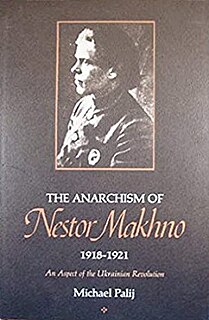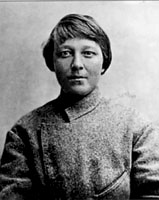 W
WThe 1st Donetsk Corps was a military formation of the Revolutionary Insurgent Army of Ukraine, it was created on September 1, 1919 and existed until 1920.
 W
WThe Air Fleet of the Revolutionary Insurgent Army of Ukraine was one of the branches of the Revolutionary Insurgent Armed Forces.
 W
WThe Anarchism of Nestor Makhno, 1918–1921 is a book-length study of Nestor Makhno written by Michael Palij and published by the University of Washington Press in 1976.
 W
WPeter Andreyevich Arshinov, also known as P. Marin (1886–1937), was a Ukrainian anarchist revolutionary and intellectual who chronicled Nestor Makhno's 1919–1921 uprising.
 W
WPanteleimon "Panteley" Fedorovich Belochub, , was a Ukrainian soldier best known as one of the commanders of the Revolutionary Insurrectionary Army of Ukraine, a major belligerent force during the Russian Civil Wars of 1917 – 1921.
 W
WBlack Guards were armed groups of workers formed after the February Revolution and before the final Bolshevik suppression of other leftwing groups. They were the main strike force of the anarchists. They were created in the Summer of 1917 in Ukraine by Maria Nikiforova, and expanded in January 1918 to Moscow, under the control of anarchists at industrial enterprises by Factory and Plant Committees and by Moscow Federation of Anarchist Groups cells.
 W
WHuliaipole is a city in Zaporizhzhia Oblast, Ukraine. It serves as the administrative centre of Huliaipole Raion. It is known as the birthplace of Ukrainian anarchist revolutionary Nestor Makhno. It has a population of 13,262
 W
WSimon Mikytovich Karetnik was a Ukrainian anarchist and a commander of the Revolutionary Insurrectionary Army of Ukraine (RIAU). He often replaced Nestor Makhno as supreme commander of the Black Army in 1920. Karetnik gained a reputation for his central role in defeating the White Army in Crimea in November 1920.
 W
WAgafya "Halyna" or "Galina" Andreyevna Kuzmenko Makhno was a Ukrainian teacher and anarchist, and the wife of Nestor Makhno.
 W
WNestor Ivanovych Makhno, commonly known as Bat'ko Makhno, was a Ukrainian anarchist revolutionary and the commander of an independent anarchist army in Ukraine from 1917–21.
 W
WMakhnovia, also known as the Free Territory, resulted from an attempt to form a stateless anarchist society in parts of Ukraine during the Russian Revolution of 1917–1923. It existed from 1918 to 1921, during which time free soviets and libertarian communes operated under the protection of Nestor Makhno's Revolutionary Insurrectionary Army. The area had a population of around seven million.
 W
WMaria Grigor'evna Nikiforova, was an anarchist partisan leader. A self-described terrorist from the age of 16, she was known widely by her nickname, Marusya. Through her exploits she became a renowned figure in the anarchist movement of 1918–1919 in Ukraine during the Russian Civil War.
 W
WPlatformism is a form of anarchist organization that seeks unity from its participants, having as a defining characteristic the idea that each platformist organization should include only people that are fully in agreement with core group ideas, rejecting people who disagree. It stresses the need for tightly organized anarchist organizations that are able to influence working class and peasant movements.
 W
WThe Revolutionary Insurrectionary Army of Ukraine, also known as the Black Army, or as Makhnovtsi, after their leader Nestor Makhno, was an anarchist army formed largely of Ukrainian peasants and workers during the Russian Civil War of 1917–1922. They protected the operation of "free soviets" and libertarian communes in the Free Territory, an attempt to form a stateless libertarian communist society from 1918 to 1921 during the Ukrainian War of Independence. They were founded and inspired based off the Black Guards.
 W
WFedir Shchus, also Fyodor Shuss or Feodosiy Shchus, was a commander (ataman) in the Revolutionary Insurrectionary Army of Ukraine of Nestor Makhno. Schus played one of the most important roles in the history of both the Makhnovist movement and the civil war in general. He became a symbol of rebellion.
 W
WVsevolod Mikhailovich Eikhenbaum, known later as Volin or Voline (Во́лин), was a Russian anarchist who participated in the Russian and Ukrainian Revolutions before being forced into exile by the Bolshevik Party. He was a proponent of the anarchist organizational form known as synthesis anarchism.
 W
WLev Nikolaevich Zadov (Zinkovsky), April 11, 1893, Veselaya - September 25, 1938, Kiev was chief of military intelligence of the Revolutionary Insurrectionary Army of Ukraine, and later an OGPU operative. Born Lev Zadov, he changed his last name to Zinkovsky.